
current / archive / issues / faq / RSS feed / twitter /
Blog Archive: June 2019
A Time Of Titans!The previous issue of 'Super-Villain Team-Up' ended with a promise of "a new artist! a new writer! and a new direction from your humble house of ideas!" and while this one does indeed have a new creative team, it feels much more like a fill-in rather than a new direction. Bill Mantlo, King Of Fill-Ins, only stays for this one story, although "story" is perhaps a generous description as it basically consists of one long fight, with half a sub-plot flown in from an entirely different series altogether. At times the whole thing is so lightweight that it almost becomes comical!
It all starts right where the last issue left off, with Namor suddenly becoming a lot less sanguine about Doctor Doom murdering Attuma's jester. Doom is having none of this and makes to leave, but Namor hasn't finished.
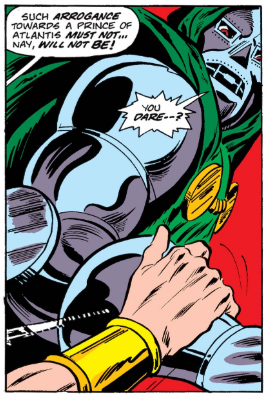 This leads to a big fight which takes them most of the issue to sort out, with the two characters knocking seven shades of super-villainy out of each other. The fight is watched by a navy vessel which has come in search of the "energy accumulation" that the two are generating. The ship, it turns out, is carrying Simon Ryker, the mad scientist who eventually creates Deathlock, along with a body floating in a tank of Protogen Gel.
This leads to a big fight which takes them most of the issue to sort out, with the two characters knocking seven shades of super-villainy out of each other. The fight is watched by a navy vessel which has come in search of the "energy accumulation" that the two are generating. The ship, it turns out, is carrying Simon Ryker, the mad scientist who eventually creates Deathlock, along with a body floating in a tank of Protogen Gel.
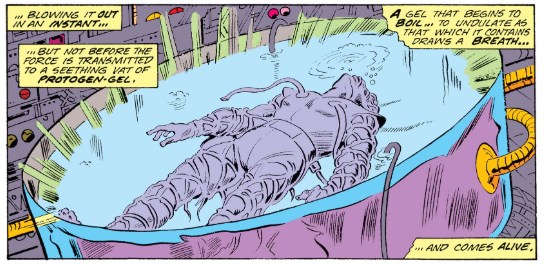 I don't know enough about Deathlock to say which version of the character this is meant to be, or even if it is Deathlock, and there's nothing in this story to explain what's going on or where this fits in continuity. This in itself is unusual, as other recent stories have gone out of their way to point out exactly where they fit in the general continuity.
I don't know enough about Deathlock to say which version of the character this is meant to be, or even if it is Deathlock, and there's nothing in this story to explain what's going on or where this fits in continuity. This in itself is unusual, as other recent stories have gone out of their way to point out exactly where they fit in the general continuity.
Meanwhile Doom and Namor continue to fight, with Doom using his forcefield to tire his opponent out before retaliating. When he does, however, he discovers that Namor was only pretending to be knackered, and is still strong enough to throw Doom into the nearby ship.
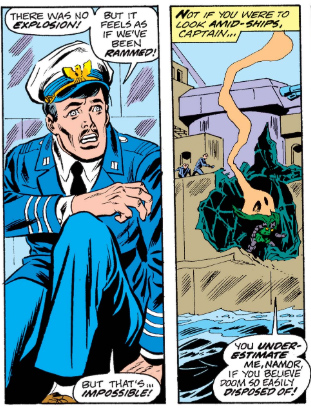 Doom recovers in time to fight back, blasting Namor with an apparently fatal dose of "pure energy", but then is grabbed from behind by Ryker with some sort of Power Syphon.
Doom recovers in time to fight back, blasting Namor with an apparently fatal dose of "pure energy", but then is grabbed from behind by Ryker with some sort of Power Syphon.
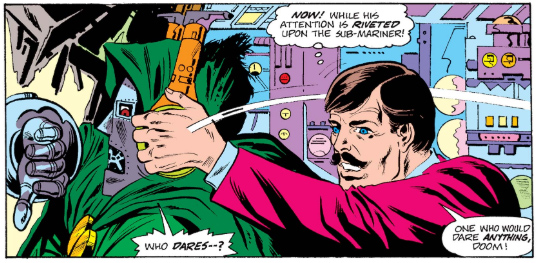 This is a neat reversal of a trick which Doom has previously used on The Silver Surfer, and it provides enough power to bring Ryker's creature to life. We don't actually find out what that means, however, as Doom throws Ryker around and then, full of joy because he thinks he's killed Namor, flies away.
This is a neat reversal of a trick which Doom has previously used on The Silver Surfer, and it provides enough power to bring Ryker's creature to life. We don't actually find out what that means, however, as Doom throws Ryker around and then, full of joy because he thinks he's killed Namor, flies away.
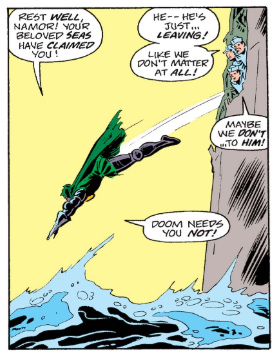 Namor, of course, isn't dead at all, and the issue ends with him bashing up some rocks in frustration. And then that's it, with no resolution to the the whole Ryker/Deathlock storyline, and none forthcoming in the following issue either. Apart from that the entire comic has been taken up with a single fight, almost as if it was, well, a fill-in while we wait for Steve Englehart to take over next time.
Namor, of course, isn't dead at all, and the issue ends with him bashing up some rocks in frustration. And then that's it, with no resolution to the the whole Ryker/Deathlock storyline, and none forthcoming in the following issue either. Apart from that the entire comic has been taken up with a single fight, almost as if it was, well, a fill-in while we wait for Steve Englehart to take over next time.
Before we get to that on this blog, however, the bi-monthly schedule of 'Super-Villain Team-Up' means we can fit in a three issue run of Doctor Doom guest-starring in Marvel's other team-up series, featuring the return of his time machine - next time!
posted 26/6/2019 by MJ Hibbett
(click here for permanent link)
(0) comments
If Vengeance Fails!
This issue kicks off right where the last one ended, with a furious Namor ready to kill Dr Dorcas for murdering his wartime girlfriend. Angry Heroes Intent On Revenge is nothing new in the Marvel Universe - raw human emotion was the main selling point after all - but usually the hero would be talked down from actually hurting people by their friends. Here Namor's friend is Doctor Doom, who simply watches the ensuing fight for a while before zapping everybody with a "stun-shock" to stop them.
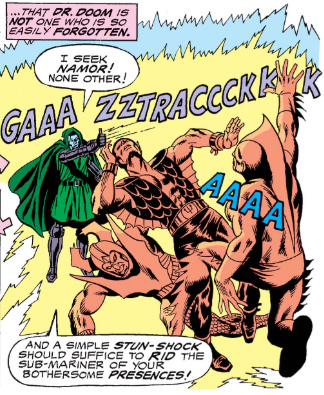 Doom knocks Namor unconscious, who later wakes up to see Doom chatting with the other villains. This cues up another fight, and this time Doom does try and calm Namor, begging him to calm down and not be ruled by his emotions.
Doom knocks Namor unconscious, who later wakes up to see Doom chatting with the other villains. This cues up another fight, and this time Doom does try and calm Namor, begging him to calm down and not be ruled by his emotions.
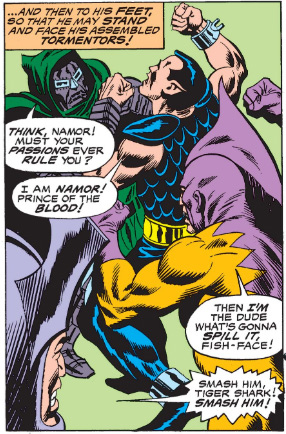 This is a bit rich coming from him, as we shall soon see, but before the group can start thumping each other the pair are teleported away to Doom's ship, where Namor collapses again.
This is a bit rich coming from him, as we shall soon see, but before the group can start thumping each other the pair are teleported away to Doom's ship, where Namor collapses again.
When he wakes up he finds he's been transported to a health facility in Doom's castle, where loyal Latverians are happily serving their master.
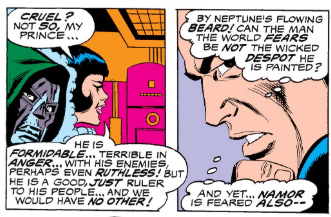 Namor considers this, and comes to a similar conclusion to Betty in the previous issue. "Can the man the world fears be not the wicked despot he is painted? And yet... Namor is feared also," he thinks. Here Jim Shooter, taking over for this issue from Tony Isabella, is similarly casting doubt on the trustworthiness of Marvel's own "reporting" of their storyworld. It's a really nice way of helping the reader to sympathise with characters who they should really be booing.
Namor considers this, and comes to a similar conclusion to Betty in the previous issue. "Can the man the world fears be not the wicked despot he is painted? And yet... Namor is feared also," he thinks. Here Jim Shooter, taking over for this issue from Tony Isabella, is similarly casting doubt on the trustworthiness of Marvel's own "reporting" of their storyworld. It's a really nice way of helping the reader to sympathise with characters who they should really be booing.
Doom offers "constructive" criticism, telling Namor that he was stupid to go into battle unprepared. This leads to heated words during which Doom also loses his rag.
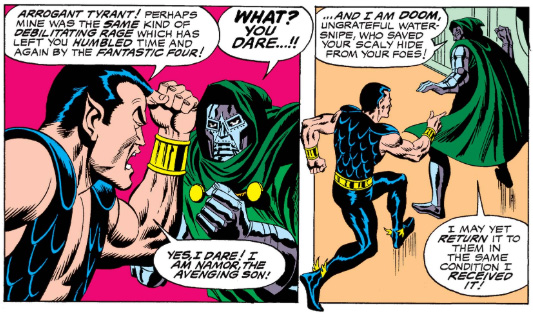 The pair quickly come to their senses, and then set off back to Hydrobase, where Doom has concocted a plan of attack. It all goes brilliantly well, with him distracting Attuma's armies to allow Namor to sneak into the base to free the prisoners - once again, Tiger Shark, Dr Dorcas and Attuma are shown to be the baddies of the story by the fact that they've kept hostages, while Namor and Doom are the liberators.
The pair quickly come to their senses, and then set off back to Hydrobase, where Doom has concocted a plan of attack. It all goes brilliantly well, with him distracting Attuma's armies to allow Namor to sneak into the base to free the prisoners - once again, Tiger Shark, Dr Dorcas and Attuma are shown to be the baddies of the story by the fact that they've kept hostages, while Namor and Doom are the liberators.
With that done Namor returns to the main battle to continue the plan, using a freeze-ray gun given to him by Doom to stop his enemies in their tracks. It's all going really well, until Namor decides that this isn't how he wants to win, and smashes the gun up so he can have a proper fight instead.
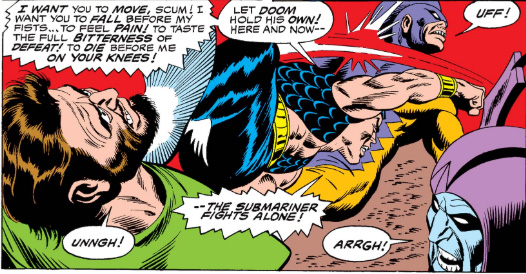 It's noticeable that Namor says again that he wants to kill them - there's no chance of him tying them up and dropping them off at the police station like Spider-Man would.
It's noticeable that Namor says again that he wants to kill them - there's no chance of him tying them up and dropping them off at the police station like Spider-Man would.
This is all well and good for Namor, but it leaves Doom high and dry without reinforcements, and he is soon overwhelmed by Attuma's army. As Attuma's jester mocks him, Doom scrabbles around in the sound and finds a couple of handy high-explosive missiles which he is able to slam together, killing everybody else around him.
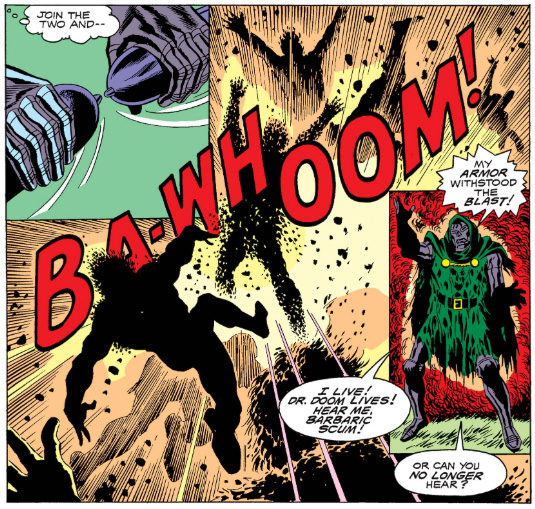 There's no escaping, and no robot doubles here - Doom has just killed a whole bunch of people. Namor then does the same, throwing Tiger Shark at a nearby Octo-Mek, forcing it to collapse and apparently kill Dr. Dorcas.
There's no escaping, and no robot doubles here - Doom has just killed a whole bunch of people. Namor then does the same, throwing Tiger Shark at a nearby Octo-Mek, forcing it to collapse and apparently kill Dr. Dorcas.
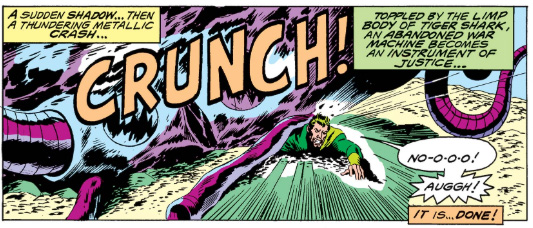 There's more murdering to come, as Namor heads back to the beach where he finds Doom taking his revenge on the Jester, giving him a couple more missiles which he asks him to smash together, so that the poor Jester explodes.
There's more murdering to come, as Namor heads back to the beach where he finds Doom taking his revenge on the Jester, giving him a couple more missiles which he asks him to smash together, so that the poor Jester explodes.
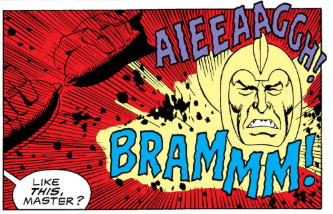 Namor is not impressed, but Doom tells him to mind his own business, which in the circumstances seems fair enough.
Namor is not impressed, but Doom tells him to mind his own business, which in the circumstances seems fair enough.
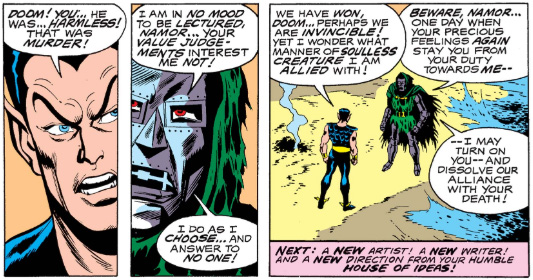 And so ends a story where a pair of self-obsessed villains merrily murder a whole bunch of people, and then stand together at the end proposing an alliance that neither of them expect to last long. It's all a bit bleak and oddly unsatisfactory, at least for someone used to conventional superhero stories where, in the end, something good comes out of it.
And so ends a story where a pair of self-obsessed villains merrily murder a whole bunch of people, and then stand together at the end proposing an alliance that neither of them expect to last long. It's all a bit bleak and oddly unsatisfactory, at least for someone used to conventional superhero stories where, in the end, something good comes out of it.
posted 20/6/2019 by MJ Hibbett
(click here for permanent link)
(0) comments
In the Midst of Life...!
In many ways Super-Villain Team-Up is like a glimpse into the (then) future of comics, to the "grim'n'gritty" 90s when the superheroes of the time would happily kill anyone who got in their way without a second thought. In this issue, for instance, Doom and Namor are meant to be forging an alliance, based on Doom's slightly creepy plan to demonstrate to Namor how much he needs him by saving him from his enemies, and along the way they behave in ways which would have been unthinkable for heroes of the time. However, they also get to demonstrate some of the soul-searching that had always been part of the Marvel Universe, leading to questioning of boundaries between "good" and "evil".
It starts with Namor defeated, and Doom watching proceedings, as he tends to, from a distance via his viewing screen. He does this via a robot fish which he'd sent to follow Namor around, which unfortunately is discovered by Tiger Shark, one of the Submarinor's captors.
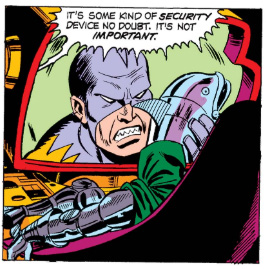 This is followed by almost two full pages of silent captions as Doom hops into a rocket ship like a romantic hero, off to save his beloved.
This is followed by almost two full pages of silent captions as Doom hops into a rocket ship like a romantic hero, off to save his beloved.
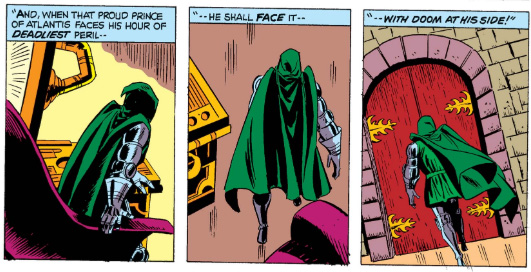 He arrives on Hydro Base, the island where Namor has been trapped, and is greeted first by an electric tripwire (which he defeats easily thanks to a rather neat callback to he and Namor's very first meeting) and then by Octo-Meks. These are eight-limbed defensive vehicles, which Doom forces to fight each other using his "instant hypnotism optimiser."
He arrives on Hydro Base, the island where Namor has been trapped, and is greeted first by an electric tripwire (which he defeats easily thanks to a rather neat callback to he and Namor's very first meeting) and then by Octo-Meks. These are eight-limbed defensive vehicles, which Doom forces to fight each other using his "instant hypnotism optimiser."
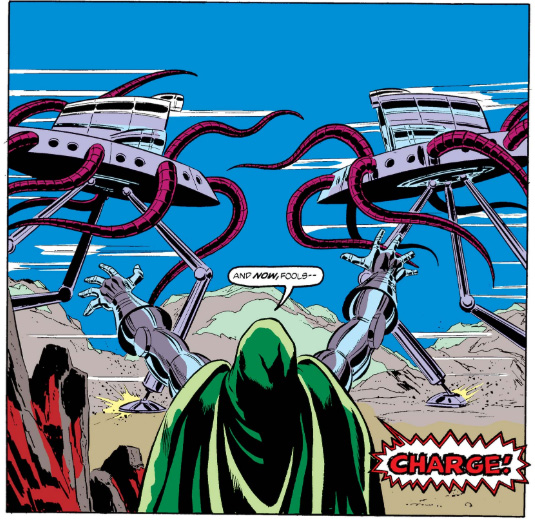 Doom then meets Betty Dean Prentiss, Namor's former girlfriend from the war years who is also living on Hydro Base. He reveals that he knows all about her - almost as if he's been looking up his crush's exes on Facebook.
Doom then meets Betty Dean Prentiss, Namor's former girlfriend from the war years who is also living on Hydro Base. He reveals that he knows all about her - almost as if he's been looking up his crush's exes on Facebook.
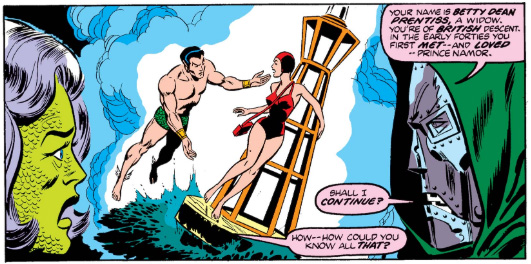 Doom tells her he's a friend of Namor, which she finds hard to believe at first as he's a well known villain, but then again "Namor's gotten some awfully bad press though, so I guess the same thing could have happened to you." It's an interesting way to cast Doom as a possible hero again, as if everything we've learnt previously about him could have been Fake News.
Doom tells her he's a friend of Namor, which she finds hard to believe at first as he's a well known villain, but then again "Namor's gotten some awfully bad press though, so I guess the same thing could have happened to you." It's an interesting way to cast Doom as a possible hero again, as if everything we've learnt previously about him could have been Fake News.
Doom does act like a hero here, calmly setting off to save his friend with Betty in tow, using his gadgets to steadily make his way into their enemies' lair. When they arrive the other villains greet him as an equal, but then demonstrate that they are actually more evil than Doom by hitting Betty.
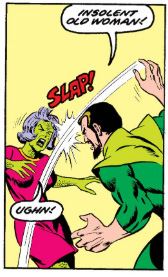 This is in marked contrast to Doom's gentlemanly behaviour, and leads to tragedy as Namor tries to escape to help her, only for Betty to get caught up in the crossfire of a super-villain battle, and end up dead.
This is in marked contrast to Doom's gentlemanly behaviour, and leads to tragedy as Namor tries to escape to help her, only for Betty to get caught up in the crossfire of a super-villain battle, and end up dead.
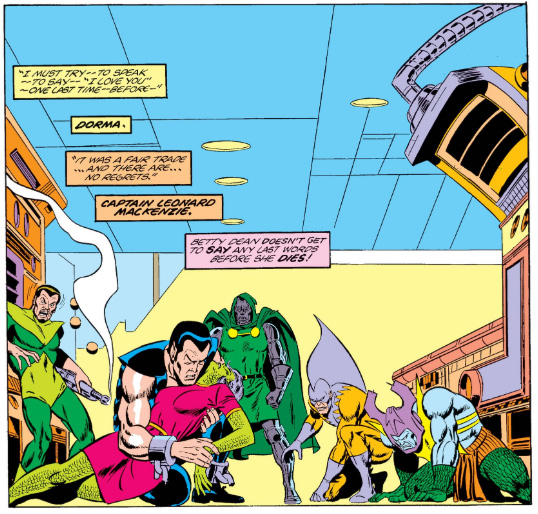 The issue ends with a furious Namor, with murder in his eyes, ready to take vengeance for the death of someone he loves. If this were a superhero led comic we'd expect a friend to step in and stop him, but Namor's friend is Doctor Doom, so who knows what'll happen? See you next time to find out!
The issue ends with a furious Namor, with murder in his eyes, ready to take vengeance for the death of someone he loves. If this were a superhero led comic we'd expect a friend to step in and stop him, but Namor's friend is Doctor Doom, so who knows what'll happen? See you next time to find out!
posted 17/6/2019 by MJ Hibbett
(click here for permanent link)
(0) comments
The Fantastic Four Radio Show
The Fantastic Four Radio Show was a series that ran on syndicated radio for 13 weeks in 1975. There's an extremely interesting interview with the Producer, Peter B Lewis, at Kleefeld On Comics where he discusses how it came to be made, cast, and broadcast, and how it pretty much ruined him financially. The short version is that he originally hoped to make a "Silver Surfer" radio show but thought the FF would be a better place to start, got together some actors (including a young Bill Murray), put the whole thing together himself, and then never really got the funding he needed to make it work. The full interview is well worth a read!
The shows were originally broadcast daily in five minute sections, with each week's episodes making up an adaptation of a single comic, taken from the very earliest issues of the series. You can listen to all of the episodes for free over on Archive.Org, and they are also well worth a listen as they're a lot of fun, although I'm not sure how much actual sense they would make if you haven't read the comics already - I was reminded quite powerfully how much comics relies on visuals, especially when you have characters who stretch or turn invisible!
The adaptations themselves are pretty interesting, as they follow the original comics fairly closely, but not literally. A lot of the dialogue, for instance, is altered to help carry the story more clearly, or to share the lines out more equally, with the characters often describing what's happening to each other. The sound production helps it along (and is generally pretty great) and, like the Power Records audio version, Stan Lee is on hand as narrator, but even for someone who's read these stories several times already, in several different formats, there are moments when what's going on becomes unclear.
The episodes that are relevant to us on this blog are adaptations of Fantastic Four #5, Fantastic Four #16, Fantastic Four #17 and Fantastic Four #19 which all feature Doctor Doom (if only slightly for issue 19). The character is played in all of these episodes by Jerry Terheyden, who gives him the menacing air of an old b-movie villain, with a posh, superior voice and a lot of cackling. It works really well, even though sometimes the ring modulator effect on his voice makes him sound a little bit like a Dalek.
The other performances are pretty good too, with Bill Murray clearly enjoying himself and Cynthia Adler basically doing celebrity impersonations for the minor characters - for instance, Alicia Masters is performed as a semi-comatose Marilyn Monroe and Princess Pearla, bizarrely, talks exactly like Mae West!
As I say, the episodes are, for the most part, pretty faithful adaptations of the comics, except for the adaptation of Fantastic Four #5, which has the ending of Fantastic Four #10 pasted in instead of its original ending - the team-up between Namor and Doom is skipped (possibly due to rights issues?), and so instead of jumping out of a window to escape his burning castle at the end of the story, Doom is shrunk, ready to reappear in The Micro World. Another change is in Fantastic Four #17 where Doom still blackmails the president, but this time it's Richard Nixon (impersonated by a member of the cast) rather than John Kennedy.
The most curious thing, to me, about this series is the fact that they went right back to the start of the comics for their adaptations - just as most other media versions so far have done - rather than dip into other aspects of the (at this point) 14 years of publication. This tendency means that there are plenty of adaptations of some fairly clunky stories (especially "The Micro World Of Doctor Doom") while later stories in Lee & Kirby's run, which some people (me) would argue are much more worthy of adaptation, don't get touched.
I won't be going into the individual episodes in any further depth because, as I say, they are for the most part adaptations of existing comics, but they're definitely worth a listen. Next time we're back to the comics themselves, as we find out whether Namor realises how wrong he was to dump Doom!
posted 6/6/2019 by MJ Hibbett
(click here for permanent link)
(0) comments